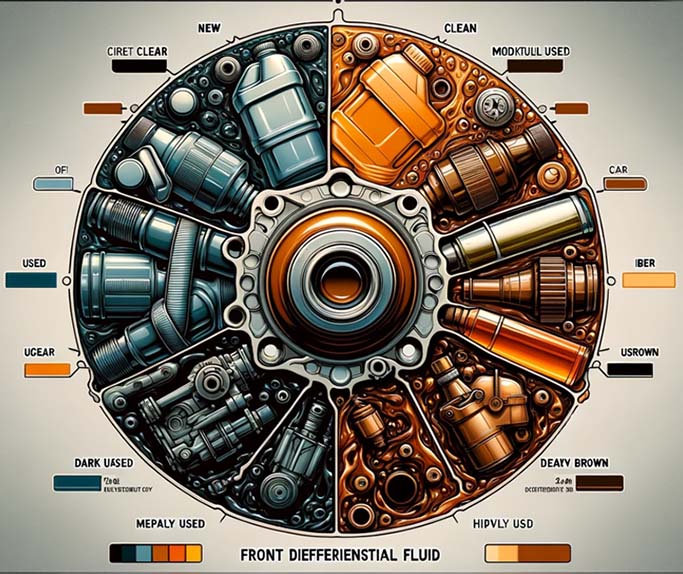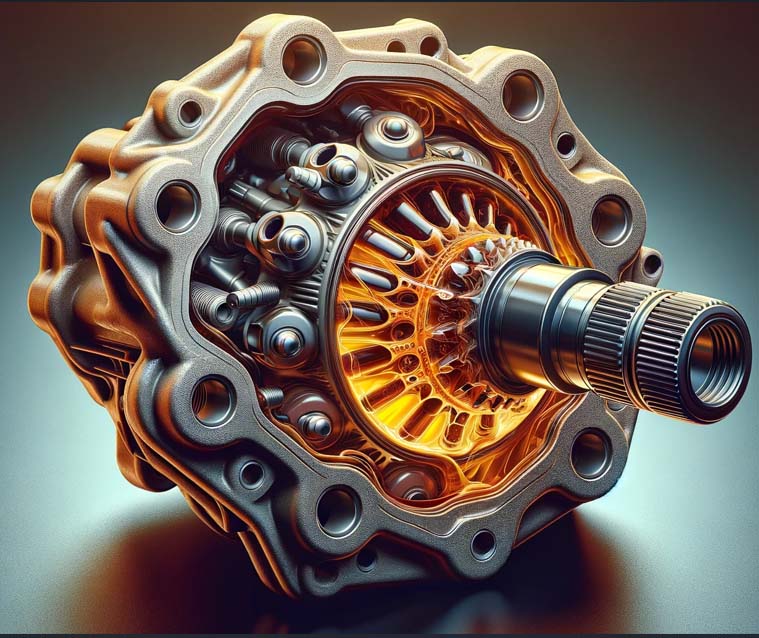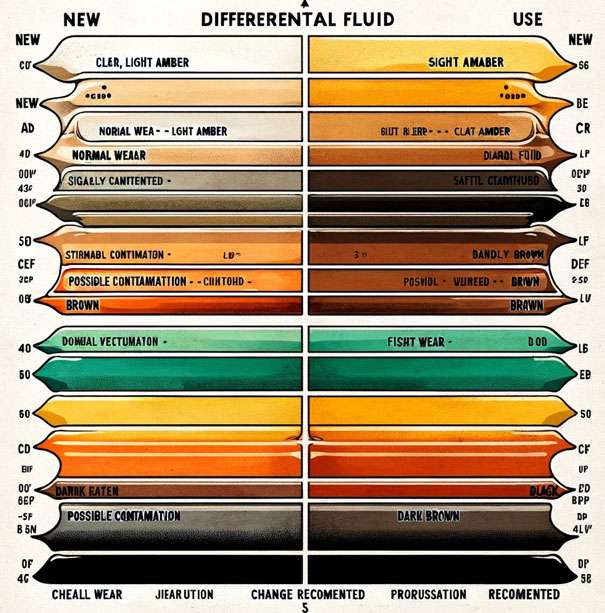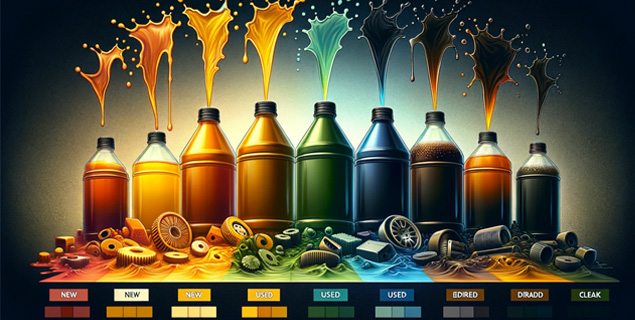What color is differential fluid, including its types, properties, and maintenance requirements, is beneficial for several reasons, particularly for those involved in automotive care, machinery maintenance, and industrial applications.
What color is differential fluid
What color is differential fluid article also helps your car run smoothly? Let’s explore with us what color is differential fluid.
What color is Front differential fluid
What color is front differential fluid is mostly like What color is differential fluid, typically ranges in color from amber to dark brown when it’s new and in good condition. The exact hue can vary depending on the specific type of gear oil used—whether it’s synthetic or mineral-based—and the presence of any additives. what color is Front differential fluid (fresh) is usually transparent to amber, similar to new engine oil, but might be slightly thicker.

Over time and with use, the color of differential fluid can darken due to the accumulation of wear particles from the gears and potential contamination. Suppose the fluid turns dark brown or black. In that case, it often indicates that it is old and possibly contaminated, suggesting that a change is necessary for maintaining the differential’s performance and longevity.
What color is rear differential fluid
Much like front differential fluid, color of rear differential fluid typically starts from amber to dark brown when new and in good condition. The specific color can vary based on whether the gear oil is synthetic or mineral-based, and it may contain various additives that can also influence its color. New gear oil is generally transparent to amber, similar in appearance to fresh motor oil but possibly a bit thicker.

As the rear differential fluid ages and collects particles from gear wear and environmental contaminants, it can darken significantly. If the fluid becomes dark brown or black, it has degraded and may no longer provide adequate lubrication and protection for the differential gears. The color change indicates that the fluid needs replacement to ensure the differential operates efficiently and to prevent premature wear or damage.
What type of differential fluid should I use?
What type of differential fluid should I use, depends on several critical factors, including your vehicle’s make, model, year, the kind of differential it has (standard, limited-slip, locking, etc.), and the manufacturer’s specifications. Here’s how to determine the correct fluid for your vehicle:
Consult Your Vehicle’s Owner’s Manual: The first and most reliable source for this information is your vehicle’s owner’s manual. Manufacturers specify the type of differential fluid suitable for their cars, including the required viscosity, API GL rating, and whether or not special additives are needed for limited-slip differentials.
Manufacturer Specifications: For vehicles that require specific formulations (such as those with limited-slip differentials), the manufacturer may recommend or require the use of proprietary or particular brands of differential fluid that contain necessary additives for proper operation.
What type of differential fluid should I use by Vehicle Type and Use:
Standard Passenger Vehicles:
Most standard vehicles use a joint viscosity like 75W-90 or 80W-90, with conventional or synthetic formulations based on manufacturer recommendations.
High-Performance and Sports Cars:
Vehicles designed for high performance or frequently used in racing may require synthetic differential fluids with specific additives to handle higher temperatures and stress.
Trucks and Heavy-Duty Applications:
Trucks and vehicles used for towing or carrying heavy loads often require thicker, more durable gear oils like 85W-140, especially in high-temperature environments.
What type of differential fluid should I use by Differential Type:
Open Differentials: Typically, standard gear oils are sufficient for open differentials, following the viscosity and API GL ratings recommended by the manufacturer.
Limited-Slip Differentials (LSD):
LSDs usually require gear oils with specific friction modifiers to properly lubricate the clutch packs and prevent chatter. Some oils are labeled explicitly for LSD use.
Locking and Electronic Differentials:
These may have unique requirements, so following the vehicle manufacturer’s recommendations is essential.
Climate and Operating Conditions:
The operating environment can also influence the choice of differential fluid. In colder climates, a gear oil with a lower winter viscosity (indicated by the first number in the viscosity rating, e.g., 75W-90) may be necessary for better cold-weather performance. In contrast, hotter climates or severe driving conditions might require thicker oil for better protection.
Synthetic vs. Mineral:
Synthetic differential fluids generally offer better performance in extreme temperatures and conditions, have longer change intervals, and provide better protection but at a higher cost. Mineral (conventional) oils are more affordable and perfectly suitable for many applications, mainly if the vehicle isn’t used severely.
When in doubt, consult a professional mechanic or the vehicle’s dealership, which can provide guidance tailored to your car and driving conditions. Always ensure you’re using the correct fluid type to maintain optimal performance and longevity of your differential.
Differential Fluid Color Chart
A differential fluid color chart is a helpful reference for understanding the condition of the differential fluid based on its color. While not all manufacturers provide a specific color chart, the general idea is to assess the fluid’s condition by its appearance. Here’s a simplified overview of what the colors typically indicate:

1. Clear to Amber/Yellow:
New or in good condition. Fluid that is clear, light amber, or yellowish indicates that it is fresh and clean. This is the ideal color for differential fluid, suggesting it is providing optimal lubrication and protection.
2. Light Brown:
Normal but aging. Light brown fluid is still acceptable but indicates that the fluid has been used for a while. It may still provide adequate lubrication, but it’s getting closer to threshold point.
3. Dark Brown:
Used and should be checked. Dark brown fluid suggests that the fluid is aging and may have accumulated contaminants. It’s a sign that you should consider changing the fluid soon, especially if it’s been a long time since the last change.
4. Black or Very Dark Brown with a Burnt Smell:
Contaminated and needs changing. If the differential fluid is black or very dark brown and has a burnt odor, it’s a clear indicator that the fluid is degraded and contaminated. This fluid is not providing adequate protection or lubrication, and it should be changed immediately to prevent damage.
5. Particles or Metal Shavings:
It indicates wear or damage. If you notice metallic particles or shavings in the fluid, this is a sign of abnormal wear and potential damage within the differential. The fluid (and potentially some components) will need to be replaced, and the differential should be inspected for damage.
It’s important to note that while color can be a useful indicator of fluid condition, it’s not the only factor to consider. Always follow the manufacturer’s recommendations for maintenance intervals and fluid specifications. If you’re unsure about the condition of your differential fluid or if you notice any unusual signs (like strange noises or operation from the differential), it’s best to consult with a professional mechanic.
Outstanding Signs of The Low Level of Differential Fluid
Signs of low level Differential fluid, can lead to several noticeable symptoms and potentially cause significant damage to your vehicle’s differential over time. Awareness of these signs can help you address the issue before it escalates. Here are some outstanding signs of low differential fluid levels:
Unusual Noises:
One of the most common signs of Low Level of Differential Fluid is noise from the differential area, particularly when turning or driving at certain speeds. These noises can range from humming or whining to a howling sound, depending on the level of fluid and the extent of wear on the differential components.
Vibrations:
Signs of The Low Level of Differential Fluid can cause vibrations that may be felt through the vehicle. These vibrations are typically more noticeable at specific speeds or when accelerating.
Gear Grinding:
Insufficient lubrication from Signs of The Low Level of Differential Fluid can lead to gears grinding against each other. It is more evident during turns when the differential gears are under more stress.
Increased Wear and Tear:
The differential relies on fluid for lubrication to prevent metal-on-metal contact. Low fluid levels increase friction and wear on the gears and bearings, accelerating component wear and leading to premature failure.
Overheating:
The differential fluid also plays a crucial role in cooling the differential. Signs of The Low Level of Differential Fluid can result in insufficient cooling, causing the differential to overheat. Overheating can damage the differential components and potentially lead to differential failure.
Leaking Fluid:
Visible signs of leaking fluid from the differential housing Signs of The Low Level of Differential Fluid. Leaks might occur from the differential cover, seals, or gaskets and should be addressed to prevent further fluid loss.
Rough Handling or Turning:
If the differential doesn’t function correctly due to low fluid, you might notice a change in the handling of your vehicle, especially when making turns. The car might feel less responsive or exhibit unusual handling characteristics.
Addressing The Low Level of Differential Fluid is crucial to avoid further damage to your car’s front or rear area. If you notice any of these signs, it’s advisable to check the differential fluid level and condition. Refilling the fluid to the proper level may resolve the issue, but if the fluid is dirty or contaminated, or if there are signs of damage, a more thorough inspection and possibly repairs may be necessary. Regular maintenance and checks can help prevent these issues from happening.
How much does it cost to change the differential fluid
The cost of changing differential fluid can vary widely depending on several factors, including the type of vehicle, the type of differential fluid required (synthetic vs. conventional), labor costs in your area, and whether you’re doing it yourself or going to a professional service center. Here’s a general breakdown to give you an idea regarding cost.
Do-It-Yourself (DIY):
If you change the differential fluid, your primary costs will be the fluid and possibly a new differential cover gasket or sealant. The price for differential fluid can range from about $10 to $30 per quart, depending on the quality and type. Most vehicles require between 2 to 3 quarts. If you need a new gasket or sealant, that might add another $5 to $20 to your total cost. Therefore, DIY differential fluid change costs range from approximately $25 to $90.
Professional Service:
If you opt for professional service, the cost includes labor and materials. Labor costs vary significantly by location and service provider, but expect to pay between $80 and $150. Including the cost of the fluid and any needed parts (like a gasket or sealant), the total price at a service center can range from $100 to $250 or more.
Vehicle Type and Differential Fluid:
The cost can also be influenced by the specific requirements of your vehicle. Some high-performance or heavy-duty cars require more expensive synthetic fluids or more significant differentials requiring more fluid, which can increase the overall cost. Additionally, some vehicles have limited-slip differentials that require special additives in the fluid, adding to the cost.
Additional Services:
A differential fluid change might sometimes be part of a larger service package or performed during other maintenance tasks, affecting the overall cost.
To get an accurate estimate for your vehicle, consider checking with local auto service providers or the dealership. They can provide specific pricing based on your vehicle’s make, model, and differential type. If you’re buying the supplies for a DIY change, local auto parts stores or online retailers can give you a precise cost for the materials needed.
Conclusion
In conclusion, What Color Is Differential Fluid, what color is Front differential fluid, what color is rear differential fluid, what type of differential fluid should I use, differential fluid color chart, Signs of low level Differential fluid, How much does it cost to change the differential fluid and maintenance requirements are crucial for individuals engaged in automotive care, machinery maintenance, and industrial applications.
By being knowledgeable about these aspects, one can ensure their equipment’s proper functioning and longevity. Regularly checking and changing differential fluid according to manufacturer recommendations can help prevent costly repairs and extend the lifespan of components. Consult your owner’s manual or a professional mechanic for guidance on maintaining your specific differential system. Stay informed and proactive regarding what color Differential fluid care is to optimize your vehicles’ or machinery’s performance and efficiency.

